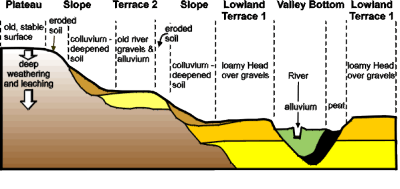
|
Soil Forming ProcessesThere are five key processes by which soil is formed, they are: Leaching - leaching is the removal of soluable components of the soil column. As water washes down through the soil it can carry away bases such as calcium, held as exchangeable ions in clay-humus complexes, as well as acidification through the substitution of hydrogen ions. Eluviation - here soil particles held in suspension, such as clay, are removed (eg. washed away). Illuviation - here soil particles held in suspension, such as clay, are accumulated (eg. deposited). Podsolisation - podsolisation occurs when strongly acid soil solutions cause the breakdown of clay minerals. As a result silica, aluminium and iron form complexes with organic substances in the soil. These minerals are removed from the surface zone of the soil and can accumulate in distinct dark sub-surface layers - very evident on inspection. Upland heaths and moors often contain podsols. Gleying - gleying occurs in waterlogged, anaerobic conditions when iron compounds are reduced and either removed from the soil, or segregated out as mottles or concretions in the soil. Marshy wetlands often contain gleyed soils. It is important to realise also that soil types are closely related
to the shape of the landscape - or its 'topography'. Soil scientists
use this to help them create soil maps. An experienced eye can
determine changes in underlying soil types when walking through
a landscape and observing changes in topography (and often vegetation
too).
|
